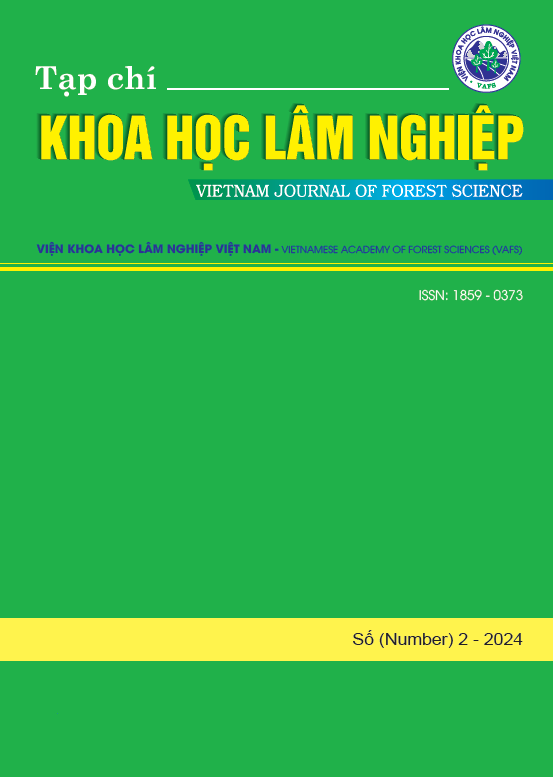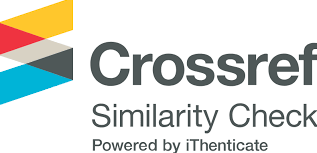STUDY ON FOREST FIRE RISK ZONATION IN THAI NGUYEN PROVINCE
Keywords:
AHP, forest fire, GIS, Fire risk, combustible materialAbstract
The research was conducted in Thai Nguyen province, aiming to build a fire risk zone map. The forest fire season in Thai Nguyen province is identified from November of the previous year to April of the following year. The study established 150 sample plots (OTCs) with an area of 1,000 m2. Within each OTC, 5 subplots (ODBs) were established to determine the volume of combustible material (VLC). The VLC was then dried in the laboratory to determine its moisture content. The Analytic Hierarchy Process (AHP) method was applied to determine the weights for the 6 map layers corresponding to 6 factors that could affect forest fire risk, including: Moisture content of combustible material classified by forest types, elevation, slope, distance to roads, distance to populated areas, and distance to agricultural cultivation areas on forestry land. The layers were classified into 5 levels of fire risk from 1 to 5, where 1 represents areas with low or no fire risk and 5 represents areas with very high/extreme fire risk. Among these factors, the most influential factors on forest fire risk are forest type and distance to farmland, with weights ranging from 0.4 to 0.16, and the lowest is slope factor with a weight of 0.09. The forest fire risk zoning map of Thai Nguyen province showed an area with high to extremely dangerous fire risk of 117,405.9 hectares, accounting for 63.8% of the total forest area.
References
Trần Quang Bảo, 2016. Nghiên cứu xây dựng phần mềm tự động phát hiện sớm cháy rừng từ Trạm quan trắc mặt đất. Tạp chí Khoa học Lâm nghiệp, số 3.
Bui, D.T., Bui, Q.T., Nguyen, Q.P., Pradhan, B., Nampak, H. and Trinh, P.T., 2017. A hybrid artificial intelligence approach using GIS-based neural-fuzzy inference system and particle swarm optimization for forest fire susceptibility modeling at a tropical area. Agricultural and forest meteorology, 233, pp.32-44.
Bế Minh Châu, 2012. Quản lý lửa rừng. NXB Nông nghiệp, Hà Nội.
Chi cục Kiểm lâm, 2022. Báo cáo tổng kết công tác quản lý bảo vệ và phòng chống cháy rừng giai đoạn 2012 - 2021, Chi cục Kiểm lâm tỉnh Thái Nguyên.
FAO. Fire Management - Global Assessment 2006. A Thematic Study Prepared in the Framework of the Global Forest Resources Assessment 14 2005. FAO, Rome. Retrievedon December 4, 2009.
Fox, D.M., Laaroussi, Y., Malkinson, L.D., Maselli, F., Andrieu, J., Bottai, L. and Wittenberg, L., 2016. POSTFIRE: A model to map forest fire burn scar and estimate runoff and soil erosion risks. Remote Sensing Applications: Society and Environment, 4, pp.83-91.
Dương Duy Khôi, Trần Quang Bảo, Nguyễn Thị Hoa, Võ Minh Hoàn và Nguyễn Văn Quý, 2020. Phân tích các nhân tố ảnh hưởng tới cháy rừng và phân vùng trọng điểm cháy rừng tại tỉnh Đồng Nai. Tạp chí Khoa học Lâm nghiệp, số 5, Viện Khoa học Lâm nghiệp Việt Nam.
Ngô Kim Khôi, Nguyễn Hải Tuất và Nguyễn Văn Tuấn, 2001. Tin học ứng dụng trong lâm nghiệp. NXB Nông nghiệp, Hà Nội
Trần Thị Ngoan, Võ Minh Hoàn, Nguyễn Thị Hạnh và Đào Thị Thùy Dương, 2021. Nghiên cứu xây dựng bản đồ phân vùng trọng điểm nguy cơ cháy rừng tại Ban Quản lý Rừng phòng hộ Tân Phú, tỉnh Đồng Nai. Tạp chí Khoa học và công nghệ Lâm nghiệp, số 2.
Saaty, T.L. and Peniwati, K. 2008. Group decision making. Drawing out and reconciling differences. Pittsburgh, PA: RWS Publications. 385 pp.
Saaty, T.L. and Vargas, L.G. 2012. New Product Pricing Strategy. In: Models, Methods, Concepts & Applications of the Analytic Hierarchy Process. International Series in Operations Research & Management Science, vol 175. Springer, Boston, MA.
Sağlam, B., Bilgili, E., Durmaz, B.D., Kadıoğulları, A.İ. and Küçük, Ö., 2008. Spatio-temporal analysis of forest fire risk and danger using LANDSAT imagery. Sensors, 8(6), pp.3970-3987.
Lê Sỹ Trung và Đặng Kim Tuyến, 2003. Quản lý và phòng chống cháy rừng. NXB Nông nghiệp, Hà Nội.
Thái Văn Trừng, 1999. Những hệ sinh thái rừng nhiệt đới ở Việt Nam. NXB Khoa học và kỹ thuật, Hà Nội.
Nguyễn Phương Văn, 2019. Nghiên cứu thực trạng và đề xuất giải pháp quản lý cháy rừng thích ứng với biến đổi khí hậu tại tỉnh Quảng Bình. Luận án tiến sỹ Lâm nghiệp, Trường Đại học Nông Lâm Huế.
Van Hoang, T., Chou, T.Y., Fang, Y.M., Nguyen, N.T., Nguyen, Q.H., Xuan Canh, P., Ngo Bao Toan, D., Nguyen, X.L. and Meadows, M.E., 2020. Mapping forest fire risk and development of early warning system for NW Vietnam using AHP and MCA/GIS methods. Applied Sciences, 10(12), p.4348.
Wenhua, L., 2004. Degradation and restoration of forest ecosystems in China. Forest Ecology and Management, 201(1), pp.33-41.
Xu, D.; Shao, G.; Dai, L.; Hao, Z.; Tang, L. and Wang, H., 2006. Mapping forest fire risk zones with spatial data and principal component analysis. Sci. China Ser. E Technol, pp.140-149.









